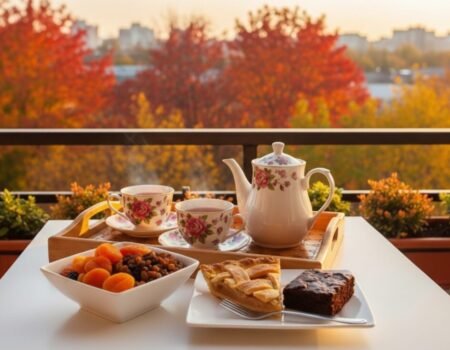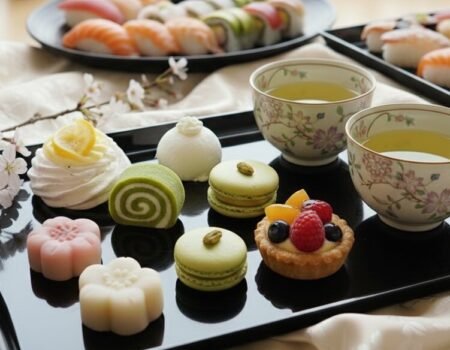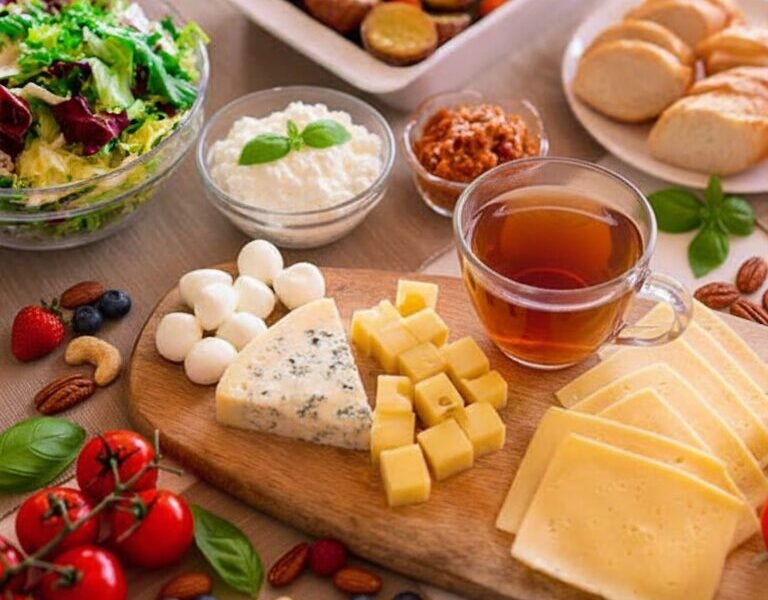
Cheese and Tea Pairing: What Tea Goes Best with Cheese
Index
Tea offers a huge range of flavors. From the light, floral notes in white tea to the deep, smoky character of pu-erh, there’s a perfect match for every cheese in your collection.
I’ll walk you through exactly how to pair cheese and tea, sharing the specific teas and cheeses that work beautifully together. You’ll discover why a cup of green tea can transform your experience with goat cheese, and how black tea cuts through the richness of aged cheddar in ways that surprise your palate.
Key Takeaways
- Pair tea and cheese by matching strength levels. Strong teas like Assam or pu-erh work with aged cheeses, while light teas like green or white complement soft, fresh cheeses perfectly.
- Tannic black teas slice through creamy textures. Floral or citrusy teas like Earl Grey brighten fatty cheeses and create balanced flavor experiences.
- Blue cheese pairs beautifully with earthy pu-erh, dark oolong, or sweet milk tea. These combinations soften sharpness without losing the complex taste notes you love.
- Serve both at optimal temperatures. Room temperature cheese and properly brewed tea bring out full flavors and aromas for the best tasting experience.
- Avoid pairing overly intense teas with delicate cheeses. This prevents overpowering the subtle dairy notes during your tasting sessions.
What Are the Principles of Tea and Cheese Pairing?
Pairing cheese with tea is all about balance.
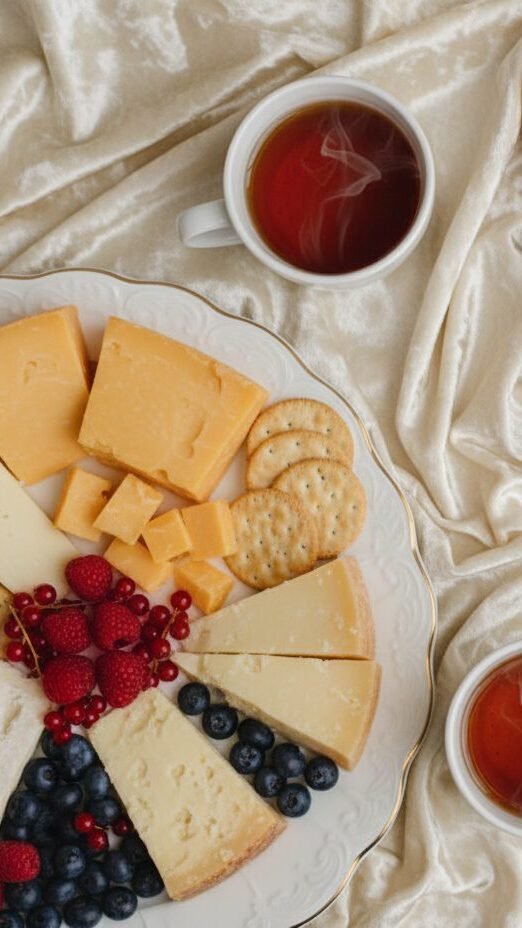
You’re creating harmony between flavors, textures, and aromas. Think of it like finding the right dance partner for each cheese.
The warmth of hot tea actually unlocks hidden flavors in cheese. According to the Republic of Tea, these subtle aromas of fruit, flowers, or smoke might be completely imperceptible without that added heat. This gives tea a unique advantage over cold beverage pairings.
Matching Intensity Levels
Soft cheeses like brie or fresh mozzarella have delicate flavors. They need light-bodied teas such as green tea or white tea.
I’ve found that green teas like sencha highlight the creamy texture of mild cheeses beautifully. The gentle grassy notes work without adding bitterness or overpowering your palate.
White tea brings floral notes that balance soft cheese. Its subtle character allows fresh dairy flavors to shine through.
Stronger teas match aged cheeses perfectly. Black tea, pu-erh, and dark oolong stand up to the bold, savory tones in aged cheddar and Parmigiano-Reggiano. A 2025 article from Tasting Table confirms that “Black teas, like red wines, offer ample amounts of the dryness that tannins bring.”
The strength in both elements supports each other’s tasting notes and delivers a satisfying mouthfeel.
Mismatched strengths overwhelm one side. Using a smoky Lapsang Souchong with delicate ricotta masks its gentle sweetness. You need to match intensity levels carefully to harmonize each bite and sip.
Complementing Fat Content
Fatty cheeses coat your mouth with thick, creamy richness. Astringent teas like green tea or black tea cut through that fat.
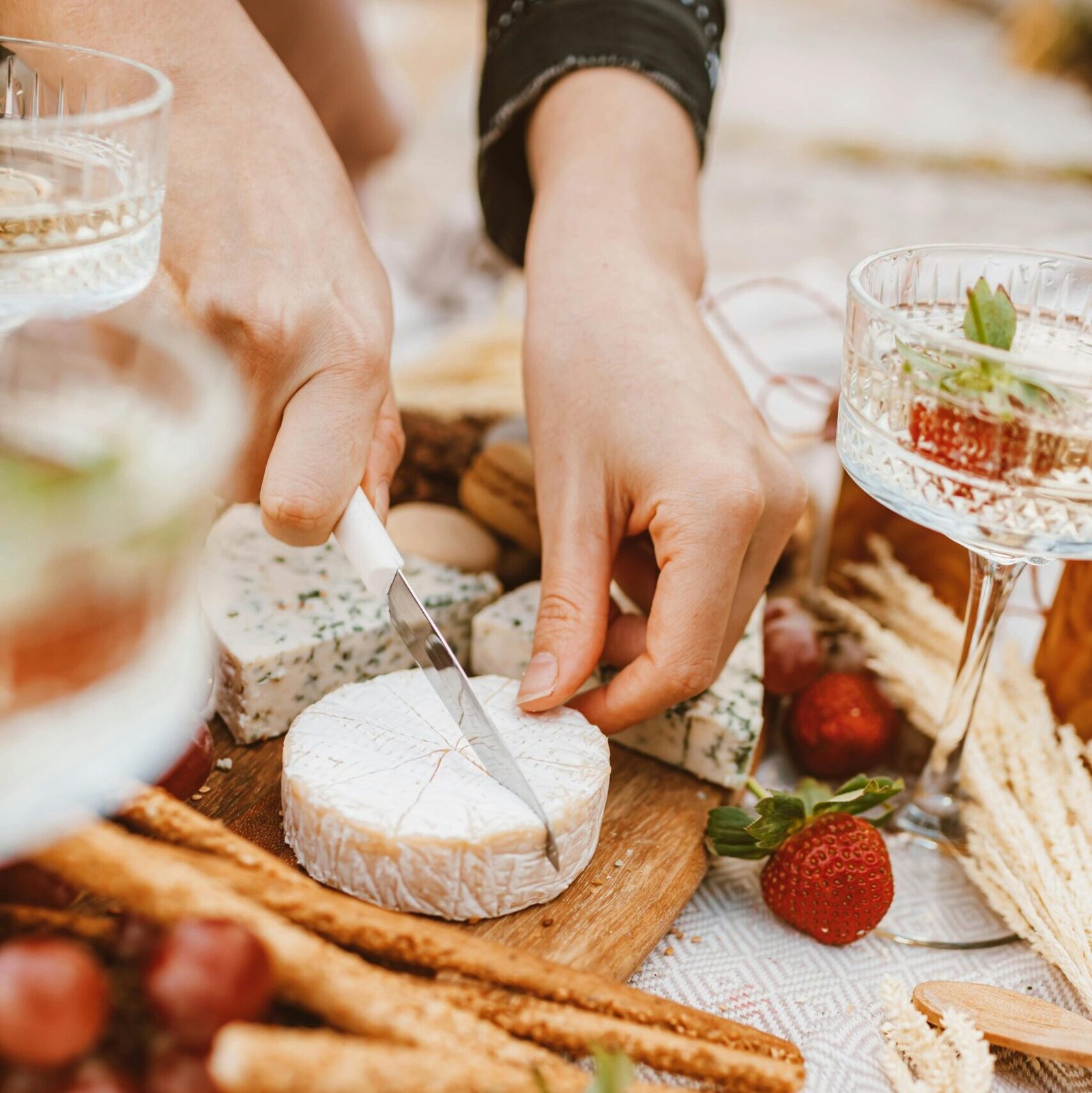
They cleanse your palate after each bite. For example, a brisk Assam paired with cheddar highlights both flavors without making your tongue feel heavy.
Floral or citrusy teas brighten up dense cheeses. Jasmine tea or Earl Grey work wonderfully with brie and triple-cream varieties. These loose leaf teas bring out hidden nuances in creamy cheeses rather than letting butteriness dominate every taste.
I’ve noticed that lighter teas refresh while stronger brews provide balance. This contrast prepares you to experience both the cheese’s flavor and the unique notes in your tea blend.
Balancing Tannins with Creaminess
Black teas and strong oolongs bring tannins. These create a drying effect in your mouth.
Cheeses like brie or burrata provide creaminess that softens the sharpness of tea tannins. When you sip tea with cheese, the creamy texture coats your tongue and mutes some of the bitterness.
This pairing works especially well with aged gouda or camembert. Their rich flavors blend beautifully with floral teas or chai.
Tannic black teas highlight the savory side of cheeses. Meanwhile, creamier cheeses enhance subtle tea notes like fruit or flowers. Try serving tea with cheese at your next gathering for new flavor experiences.
How to Pair Tea with Different Cheese Types
Different cheese types call for specific tea pairings.
You’ll discover how matching the right tea to your cheese creates surprising, delicious combinations that enhance both elements.
Fresh Cheese and Tea

Fresh cheeses have light flavors and soft, moist textures.
Herbal Tea Pairings
- Chamomile with ricotta: The gentle floral notes bring out ricotta’s delicate sweetness. Keep your infusion light to preserve the cheese’s subtle character.
- Hibiscus with mascarpone or cream cheese: Tart, fruity notes create a refreshing contrast against these rich cheeses without introducing bitterness.
- Rooibos with fresh goat cheese: This naturally sweet tea adds warmth that balances the cheese’s tangy, creamy texture.
True Tea Pairings
- Green tea with feta: Choose varieties with moderate astringency to tame feta’s sharp acidity. You’ll taste bright, grassy undertones that complement the cheese perfectly.
- White tea with mozzarella: Silver Needle and similar whites balance mozzarella’s milky aroma and slight tang while enhancing freshness on your palate.
- Fruity green teas with nut-based vegan cheese: These teas complement cashew or almond-based varieties, especially those mimicking chèvre or fresh French cheese styles.
Serving Tips
- Keep accompaniments simple: Choose cucumber slices, crisp bread, or plain crackers that won’t compete with your carefully selected flavor profiles.
- Temperature matters: Serve fresh cheeses at room temperature for optimal flavor release when paired with warm teas.
Soft Cheese and Tea
Soft cheeses present rich textures and subtle flavors. They crave delicate yet flavorful tea pairings.
Soft varieties like Brie, Camembert, and creamy goat cheese match uniquely with certain teas for a harmonious experience.
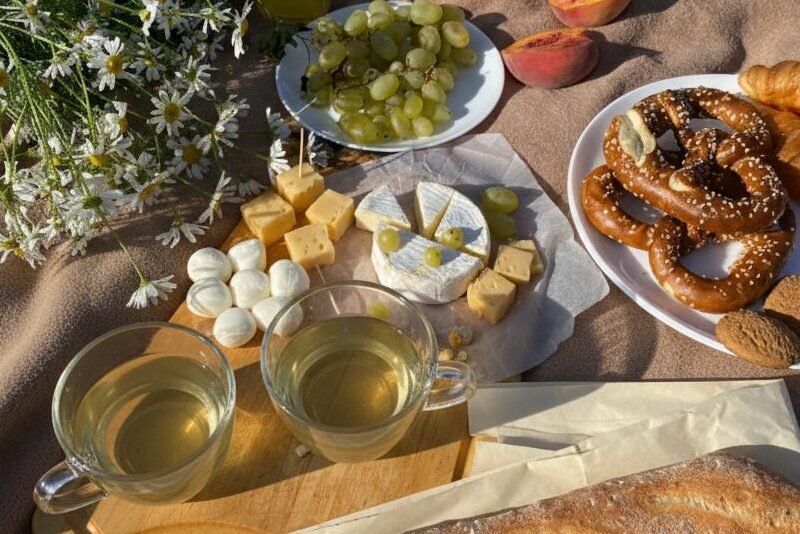
Green Tea Pairings
- Classic green with Brie: The grassy notes balance Brie’s buttery texture and create a refreshing feel on your palate.
- Jasmine green with triple cream cheeses: This scented tea highlights both floral and earthy flavors in bloomy rind varieties.
- Tie Guan Yin with Camembert: This light Chinese oolong from Fujian elevates mushroomy undertones while cutting through creamy richness.
Black & Scented Tea Pairings
- Darjeeling first flush with Robiola: The bright, crisp character contrasts beautifully against pillowy-rind varieties and their mild taste.
- Earl Grey with Saint-André: Bergamot lifts the decadent fat content of ultra-rich, triple cream styles.
- Chai with smoked or peppered soft cheeses: Warm spices cut through pungent notes while adding layers of complexity.
White & Herbal Tea Pairings
- White tea with goat cheese: Delicate floral aromas enhance the tanginess you’ll find in fresh chèvre and similar styles.
- Chamomile with young spreadable cheeses: This gentle herbal brings out sweetness that pairs perfectly with mild, creamy textures.
Quick Pairing Guide
- Have a mild cheese? Choose white or herbal teas
- Serving rich, buttery styles? Go for green or oolong varieties
- Presenting strong-flavored cheeses? Black and spiced teas work best
Semi-Hard Cheese and Tea
Semi-hard cheeses have firm textures and deep flavors.
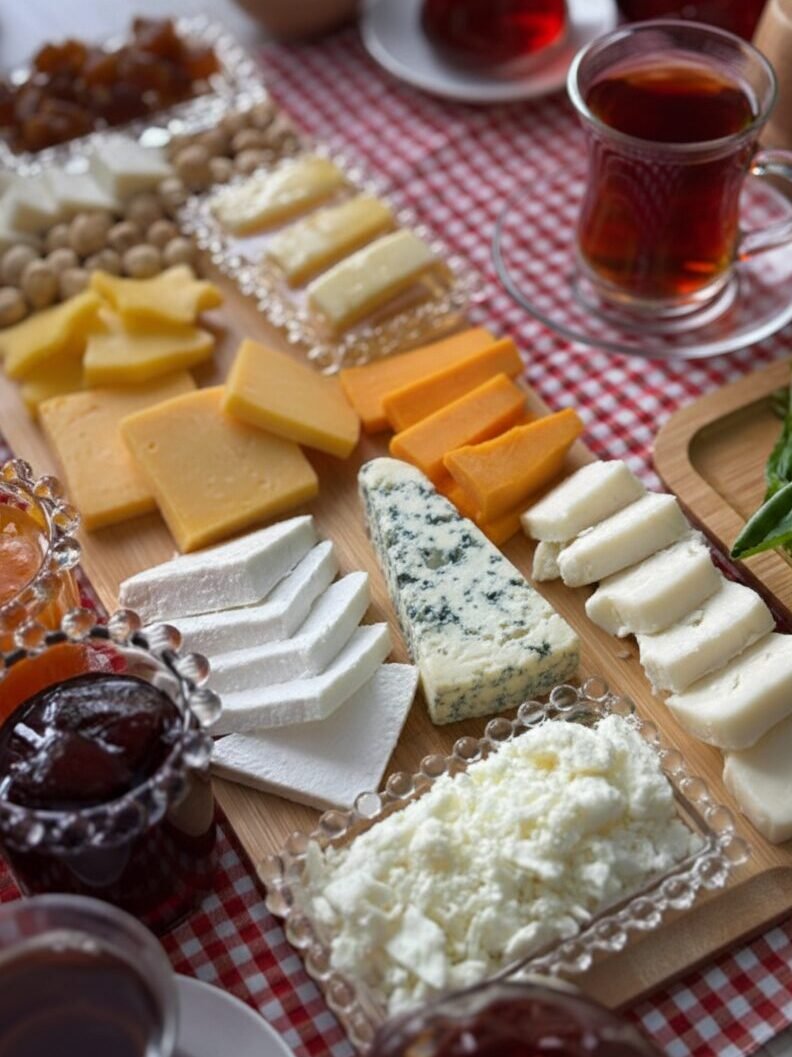
These cheeses pair well with a range of teas that highlight nutty and caramelized notes.
Black Tea Pairings
- Assam with Gouda: This malty tea enhances Gouda’s sweet, buttery flavor while balancing the cheese’s richness.
- Darjeeling with Swiss or Gruyère: The floral lift matches perfectly with these cheeses’ subtle nuttiness.
- Keemun with Emmental: Smoky aromas support the mild, savory taste of this classic semi-hard cheese.
- Ceylon with Jarlsberg: Bright acidity refreshes your palate after each rich mouthful.
Oolong & Blended Tea Pairings
- Light oolong with Havarti: This pairing brings out herbaceous undertones while complementing the creamy texture. You’ll notice how the layered floral and fruit notes align flawlessly.
- Green and black tea blends with aged Gouda: The tannins cut through fat yet preserve sweetness in both the beverage and bite.
Brewing Tips for Semi-Hard Cheese Pairings
- Use an infuser for loose leaf teas: This keeps flavors vibrant against complex notes found in most semi-hard cheeses.
- Temperature control: Steep black teas at full boil for assertiveness against rich cheeses, while oolongs need slightly cooler water to preserve their delicate layers.
Hard Aged Cheese and Tea
Hard aged cheeses like aged cheddar, Parmigiano-Reggiano, and Manchego have deep flavors and crumbly textures.
Selecting the right tea brings out nutty notes, tempers sharpness, and highlights hidden aromas.
Black Tea Pairings

- Assam or Keemun with hard cheeses: These strong black teas create full-bodied pairings that echo classic food and beverage combinations.
- Lapsang Souchong with nutty varieties: The smoky undertones accentuate nutty notes you’ll find in aged Cheddar, Comté, or similar hard cheeses.
Aged & Specialty Tea Pairings
- Pu-erh with Parmigiano-Reggiano: This earthy tea’s complex aroma and slight acidity echo the tangy crystals in aged Parmesan. Choose pu-erh that’s been stored for at least 12 months for best results.
- Dark oolong with Manchego: You’ll experience a sweet, roasted finish as the oolong’s floral character complements this Spanish cheese’s savory bite.
Serving Guidelines
- Temperature preparation: Allow cheese to reach room temperature for peak flavor expression. Pour tea at proper brewing temperature so flavors fully bloom.
- Presentation style: Cut thick wedges or cubes to maximize texture contrast with lighter or brisker teas.
Pairing Principles
- Match intensity levels: Sharper cheeses require bolder teas—strong black teas or mature pu-erh keep pace with intense flavors.
- Skip delicate teas: Their subtle aromatics disappear next to bold hard cheese tastes. Choose assertive varieties instead.
- Consider aging: The longer a cheese has aged, the more complex your tea selection can be.
Blue Cheese and Tea
Blue cheese stands out for its bold flavors and distinctive aroma.
Pairing tea with blue cheese creates combinations that highlight sharp notes, creamy textures, and complex aromas.

Bold Tea Pairings for Strong Blues
- Pu-erh with Gorgonzola: This earthy tea tames strong character while balancing creamy mouthfeel. The fermented qualities make it one of the best matches for pungent blue cheeses.
- Dark oolong with Roquefort: Floral notes and smooth tannins mellow the tangy bite. You’ll enhance both aroma and flavor without overpowering either element.
- Black tea with Danish Blue: The assertive, malty body withstands spicy veins, mirroring qualities found in traditional beverage pairings but without alcohol content.
Gentle Tea Pairings for Milder Blues
- Chamomile with lighter blue cheeses: These gentle floral flavors work beautifully with creamy textures without clashing.
- Sweet teas with Stilton: Classic milk bubble tea or teas with honey soften intense salts. The sweetness rounds out edges for a more balanced tasting experience.
Temperature Guidelines
- Cooler teas for stronger blues: Lower temperatures tame volatile aromas in pungent varieties.
- Warmer teas for creamy blues: Slightly warmer pu-erh coats thick, creamy varieties and highlights savory notes.
- Room temperature rule: Let both cheese and tea rest briefly before serving for optimal flavor harmony.
What Tea Goes with Soft Creamy Cheese?
Soft, creamy cheeses create a gentle backdrop for exploring the flavors and aromas that different teas offer.
You can discover unique pairings by experimenting with contrasting textures and subtle notes.
Green Tea with Brie
Green tea pairs beautifully with Brie.
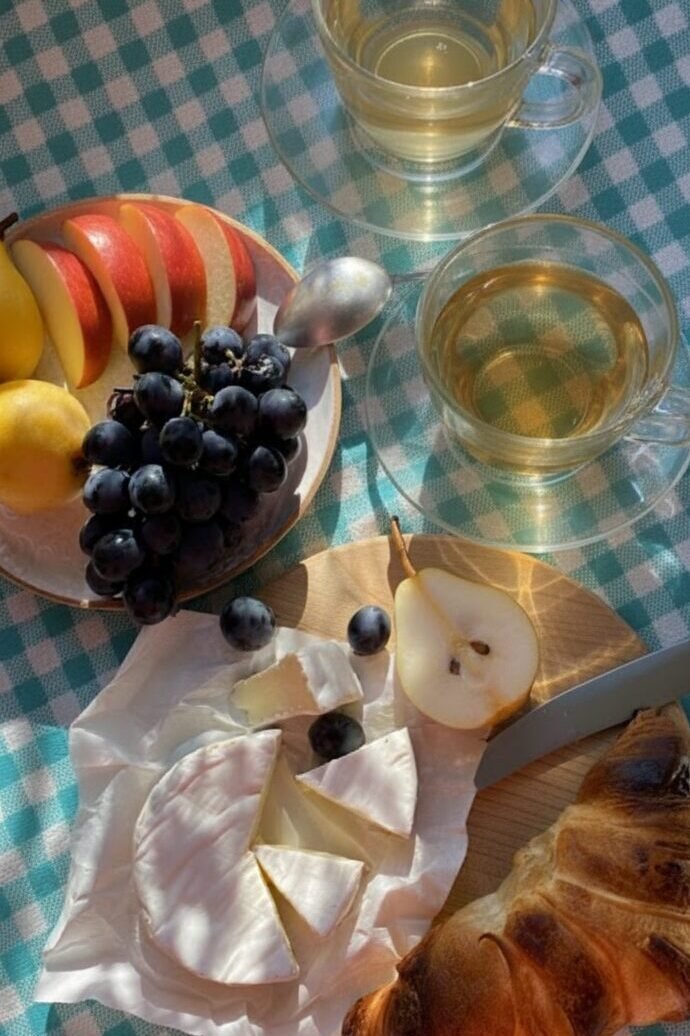
Its light astringency cuts through the rich creaminess of the cheese. The subtle grassy notes in green tea highlight the delicate flavors and aromas found in soft, creamy cheeses like Brie.
Sip a cup of Sencha or Dragon Well alongside mild Brie to refresh your palate between bites. Both offer gentle tannins that keep each taste clean while letting you enjoy both fresh milk flavors and hints of spring vegetables common in quality green teas. Culture Cheese Magazine notes that sencha, “the most popular tea in Japan, has a grassy flavor” that works perfectly with creamy cheeses.
The bright, vegetal character of green tea brings out hidden layers in this cheese. It does this without overpowering it.
With matcha, you get extra umami. Pair that with triple-cream Brie for surprising depth and complexity. You may notice how this combination echoes classic food pairings yet offers something unique for those seeking new ways to enjoy cheese and tea.
White Tea with Goat Cheese
White tea highlights the gentle tartness of goat cheese.
Its delicate floral notes and light body bring out the fresh, milky flavors found in soft chèvre. The pairing works well because white tea’s low tannin content never overwhelms the creamy texture of goat cheese.
Notice how the subtle aroma in white teas pairs with tangy cheese. This creates a refreshing balance on your palate.
You can also serve this duo with crusty bread or sliced green apple. These add extra contrast and nuance to your cheese and tea tasting board.
Light Oolong with Camembert
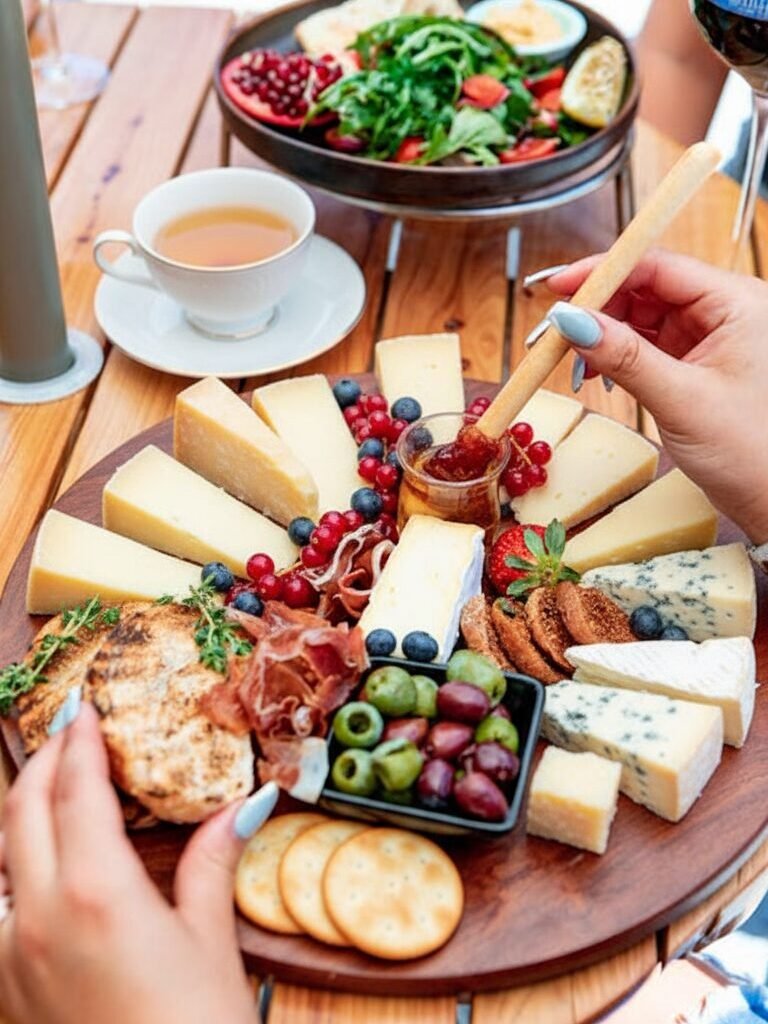
Light oolong offers a new experience with Camembert.
This semi-fermented tea has floral notes, soft honey-like sweetness, and a silky mouthfeel. These qualities match beautifully with Camembert’s rich texture and earthy aroma.
Sip a lightly roasted Tie Guan Yin or Baozhong while tasting creamy Camembert for an elegant balance. I’ve found that the subtle tannins in light oolong help cut through the fat content of this French cheese without overpowering its flavor.
Delicate flavors in both bring out nutty undertones found in Camembert. Some people may miss these when enjoying it alone. The pair creates a layered taste profile that highlights why understanding cheese types can transform your tea experience beyond black teas or herbal blends such as chamomile.
Richness meets refinement on your palate. This makes the combination special for anyone eager to create memorable cheese and tea moments at home or during tastings with friends.
What Tea Pairs with Hard Aged Cheese?
Hard aged cheeses shine when matched with bold teas.
Black tea or pu-erh create powerful combinations that you’ll want to explore for new favorites.
Black Tea with Aged Cheddar
Black tea’s tannins cut through the creamy sharpness of aged cheddar.
This creates a bold match. Strong black teas like Assam or English Breakfast bring malty and brisk flavors that stand up to cheddar’s savory depth.
Aged cheddar develops nutty notes over time. These pair well with the rich, slightly astringent finish of good black tea. For the best experience, cheese experts recommend “selecting a high-quality aged cheddar, preferably aged for at least 12 months.”
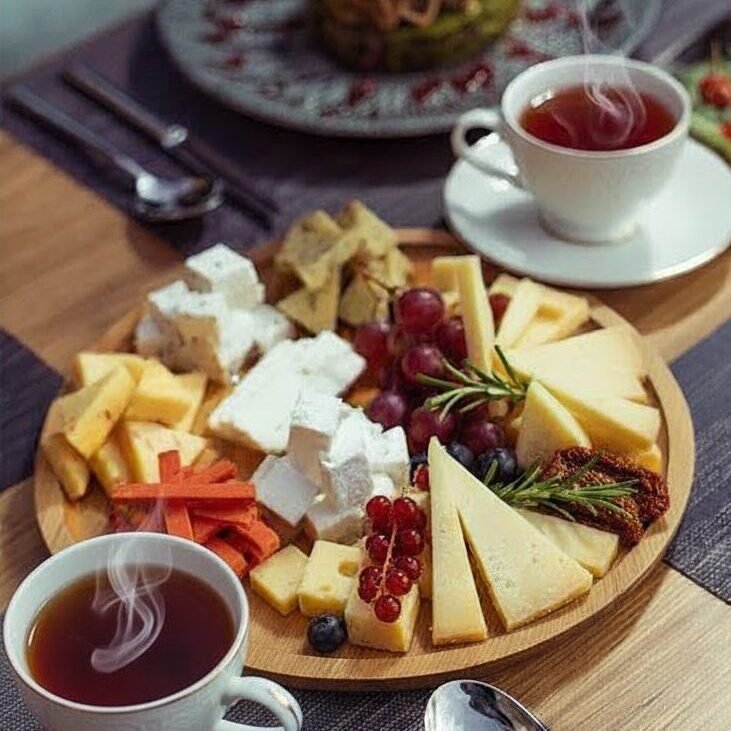
Steep your favorite black tea at a high temperature to extract its full body and complex aroma. The warmth softens the cheese just enough to release extra tanginess in each bite.
Pu-erh with Parmigiano-Reggiano
A slice of Parmigiano-Reggiano pairs beautifully with a rich, earthy cup of pu-erh tea.
The cheese offers a nutty and savory flavor that matches the deep, woody notes in aged pu-erh. As you taste the cheese, its salt crystals bring out the smoothness in the tea.
Pu-erh’s gentle tannins help cut through Parmigiano’s dense texture and lingering aftertaste. The umami from Parmigiano heightens the complexity of the tea while keeping your palate refreshed between bites.
This pairing works best during afternoon tastings or as part of a special cheese and tea board for friends. I’ve found that aged pu-erh stored in humid conditions develops particularly nice camphor and peat notes that enhance the crystalline texture of well-aged Parmigiano.
Dark Oolong with Manchego
Dark oolong tea offers layers of roasted, nutty, and stone fruit notes.
These flavors create a pleasing contrast with Manchego’s savory and buttery taste. The slight bitterness in dark oolong cuts through the richness of this Spanish sheep’s milk cheese.
As you sip the tea and savor the cheese, you may notice sweet undertones that mingle with Manchego’s grassy finish. Many taste testers find that both pair well at room temperature.
Serve slices of aged Manchego alongside a freshly brewed cup of dark oolong for best results. Try adding fresh figs or Marcona almonds to complement each bite. Their natural sweetness softens the hints of tannin from the tea.
How to Pair Tea with Blue Cheese
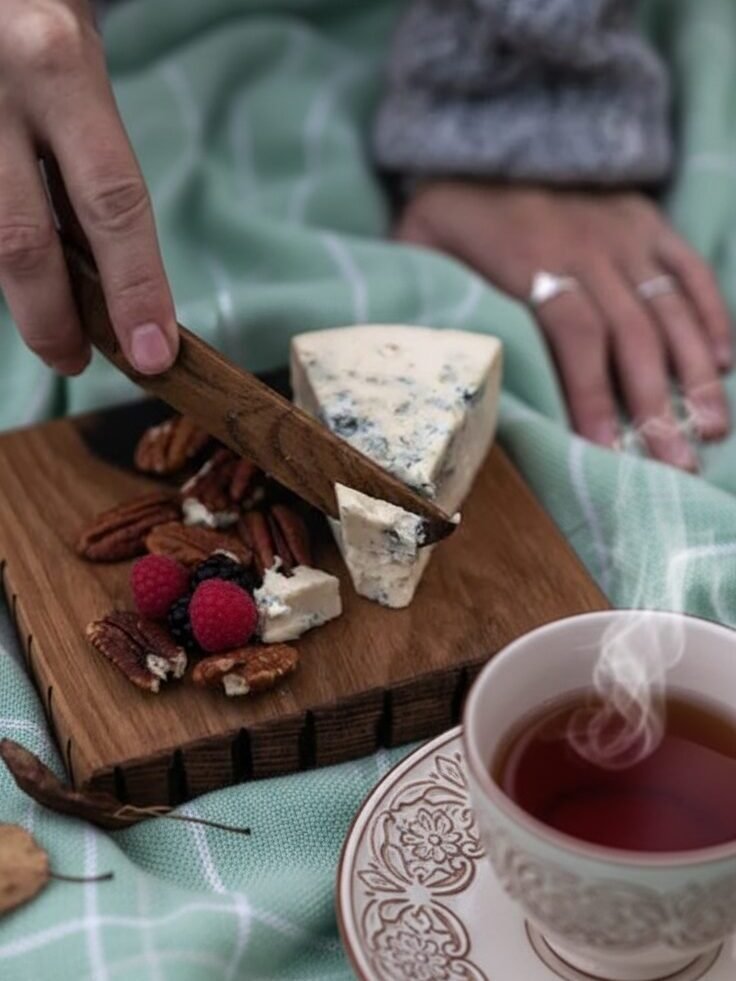
Blue cheese offers bold, salty flavors that create a unique challenge for tea pairings.
Certain teas can soften sharpness while supporting the creamy texture of blue-veined cheeses.
Pu-erh with Gorgonzola
Pu-erh tea stands up to Gorgonzola’s bold flavors and creamy texture.
The earthy, rich notes in a good ripe pu-erh cut through the tangy blue veins. Its slight sweetness softens the cheese’s sharpness.
You might notice hints of mushroom or forest floor from the tea meeting salt and cream from the cheese on your palate. Try sipping warm pu-erh before each bite of Gorgonzola.
This routine helps refresh your mouth and keeps the salty character of the cheese in check. Many people find this pairing brings out hidden caramel notes in both the tea and cheese. Each taste becomes even more interesting together than alone.
Dark Oolong with Roquefort
Dark oolong tea steps forward to meet the bold character of Roquefort.

Dark oolong delivers roasted nutty notes, hints of caramelized fruit, and a lingering floral finish that stands up well to blue cheese. Sipping this tea between bites helps smooth out Roquefort’s intense saltiness and creamy tang.
Roquefort offers sharp savory flavors with pockets of blue mold and a crumbly texture. Each mouthful feels less overpowering as dark oolong cuts through its richness while highlighting subtle sweet undertones in both cheese and tea.
Serve them side by side at room temperature for heightened aroma. This pairing transforms each bite into a balanced tasting experience.
Sweet Tea with Stilton
Sweet tea highlights the salty and tangy flavors of Stilton cheese.
The sugar in the tea rounds out Stilton’s bite. Its mild tannins keep any bitterness from building up on your tongue.
A lightly brewed black tea with a spoonful of honey or plain white granulated sugar works best for this pairing. Stilton develops creamy blue veins and crumbly edges as it ages. These melt easily against the warmth of sweet tea.
Together, they create layers of sweetness and earthiness. Enjoy sips between bites to balance sharpness from the cheese with each gentle swallow of tea. Soft dried fruits like figs or dates also lift both elements if served alongside your pairing board.
What Tea Goes with Fresh Cheese?
Fresh cheese pairs well with teas that highlight their delicate flavors and soft texture.
Specific tea choices can elevate your next cheese pairing experience beautifully.
Herbal Tea with Ricotta
Light herbal teas bring out the subtle sweetness in ricotta cheese.
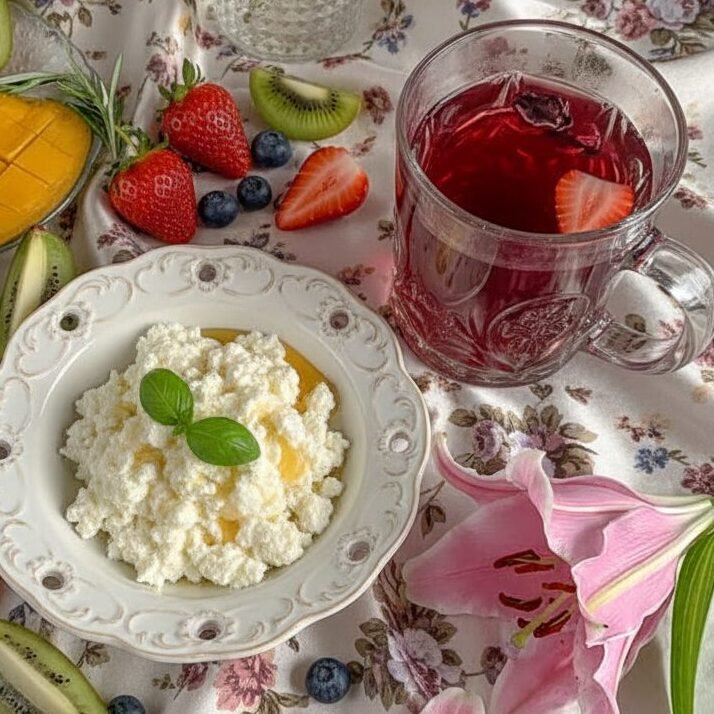
Chamomile, with its gentle floral notes, makes each creamy spoonful taste fresher and cleaner on your palate. Pair mint tea with ricotta for a refreshing mix that balances the cheese’s soft texture.
Choose caffeine-free options like rooibos when you want to highlight mild dairy flavors without any bitterness. Add slices of fresh fruit or drizzle honey over the ricotta while sipping herbal tea to create an easy appetizer at home.
Soft herbs such as basil or thyme complement both tea and cheese. This makes the pairing even more inviting during brunch or as a healthy snack.
Green Tea with Feta
The vegetal notes in Chinese or Japanese green teas cut through the salty, tangy character of feta.
This Mediterranean cheese benefits from green tea’s crisp flavors. They lighten feta’s richness and bring balance to its briny bite.
Try pairing steamed sencha or nutty long jing for best results. Sencha’s grassy tones mellow the cheese while long jing adds a subtle roasted note that echoes feta’s depth.
Enjoy these combinations chilled for warm days. Serve with salads featuring olives, cucumbers, and tomatoes to enhance your tasting experience.
White Tea with Mozzarella
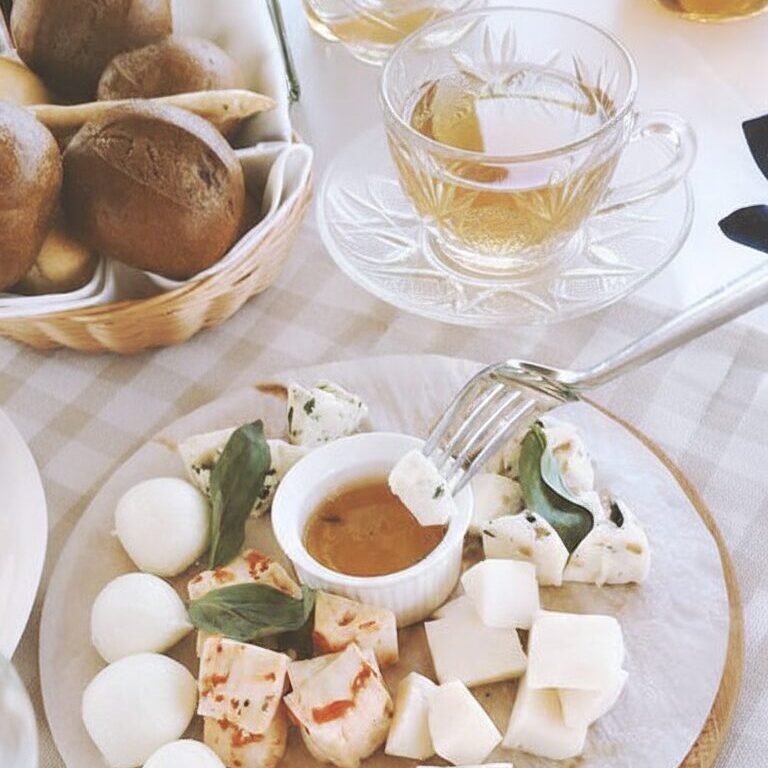
White tea’s soft flavor suits mozzarella’s fresh creaminess perfectly.
This pairing highlights subtle textures and delicate aromas instead of bold contrasts. The floral notes in white tea echo mozzarella’s milky taste.
Steep a mild silver needle or white peony to enjoy this duo at its best. Both have light bodies that don’t overwhelm the cheese. Cold mozzarella brings out the tea’s faint sweetness even more than when served warm.
Try adding sweet basil or ripe tomatoes to your plate for extra flavor layers. Keep it balanced without crowding the soft flavors of both cheese and tea.
How to Create a Tea and Cheese Tasting Board
A well-arranged tea and cheese tasting board brings out the best flavors in both elements.
It invites you to explore creative pairings throughout your next gathering. Read on for ideas that spark inspiration.
Selecting Complementary Pairings
Pair contrasting flavors and textures for balanced tea and cheese pairings.
Bright green teas can cut through the richness of soft cheeses like Brie. Aged black teas stand up to sharp cheddar or nutty Manchego.
Use herbal teas with fresh cheeses such as ricotta. The mild flavors won’t overpower each other.
Aim to match intensity levels. A strong Assam supports salty blue cheese perfectly. Delicate white tea highlights creamy goat cheese without masking its tanginess.
Arrange the cheeses and teas so their aromas invite guests to try new combinations. Start with lighter pairings and progress to bolder ones, just as you would with wine tastings.

Presentation and Serving Tips
Arrange your cheese and tea pairings on a clean wooden or slate board.
Leave space between each selection. Use small bowls for loose leaf teas, nuts, dried fruits, or honey to add interest and flavor contrast.
Serve cheeses at room temperature so their textures are soft and flavors bloom. Pour hot tea into clear glass cups to show off color and clarity. This adds visual appeal to your presentation.
Place cheese knives and tongs nearby for easy picking. This helps guests enjoy the tasting experience with minimal effort.
Start with lighter pairings and work your way to bolder combinations for the best tasting flow.
Adding Accompaniments
Fresh fruits, nuts, and honey can heighten the sensory experience of a tea and cheese tasting board.
Slices of crisp apple or pear complement creamy cheeses. Berries add tartness that contrasts with both soft and hard varieties.
Walnuts or almonds provide crunch and earthy undertones. Drizzle a bit of honey over blue cheese to soften its sharp flavors and bridge gaps between strong teas like pu-erh and assertive aged cheeses.
Include rustic crackers or thinly sliced baguette to offer a neutral base for pairing. Dried fruits such as apricots work well with salty cheeses. Their natural sweetness balances briny notes found in feta or hard aged types like Parmigiano-Reggiano.
A touch of fig jam pairs especially well with delicate white tea or green tea when served next to fresh mozzarella on your tasting board. These accompaniments create layers of flavor that make each combination more memorable.
What Are Classic Tea and Cheese Pairing Combinations?
Classic combinations celebrate tradition across cultures.
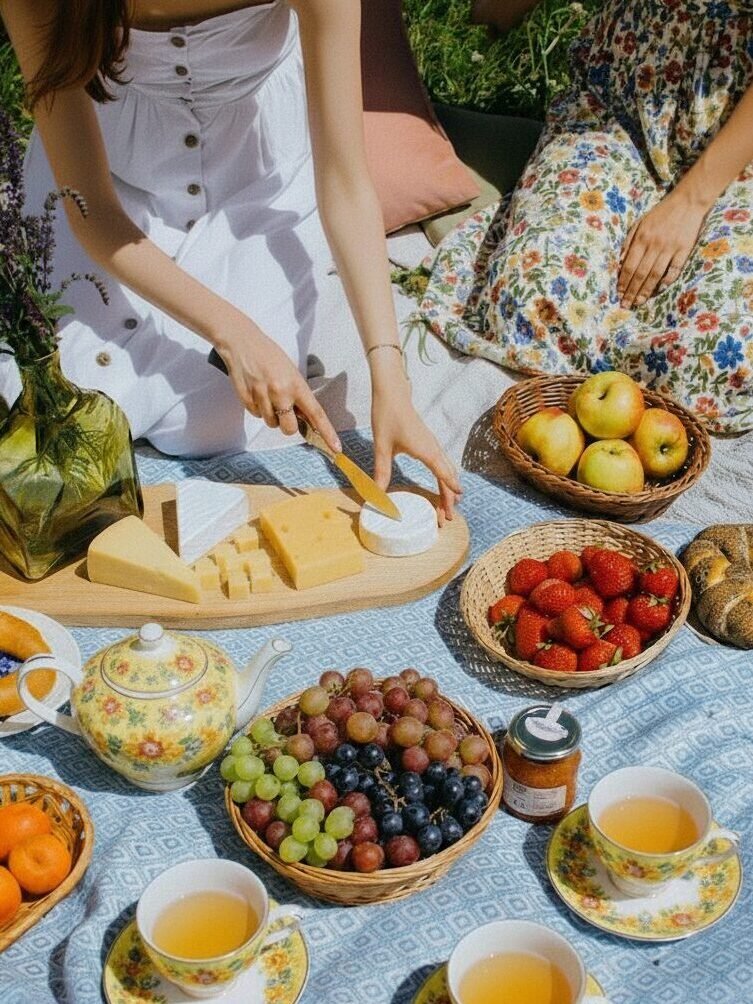
Tea and cheese create unique pairings that you can explore to inspire your next tasting.
British Afternoon Tea Cheese Pairings
Traditional British afternoon tea often features cheeses like Cheddar, Stilton, and Red Leicester.
People usually pair these with classic black teas such as Darjeeling or Assam. The bold flavors of aged Cheddar match well with the malty notes of Assam.
Mild Red Leicester tastes smooth next to a fragrant Earl Grey. The bergamot lifts the cheese’s creaminess beautifully.
Stilton stands out alongside Ceylon tea. Its blue veins offer tang and salt that balance the citrusy finish in each cup. Scones with clotted cream and cucumber sandwiches add gentle richness.
Sweet jams highlight both the cheese and strong black teas. This creates a full afternoon tea experience that celebrates harmony between savory and sweet flavors.
Chinese Tea Ceremony Cheese Pairings
Pairing cheese with Chinese tea creates a sensory experience filled with balance and depth.
Dragon Well green tea highlights the freshness of tangy chèvre. It softens the cheese’s acidity while keeping flavors bright.
Tieguanyin oolong matches well with creamy young cheeses like Camembert. It creates a floral lift that balances buttery textures.
Pu-erh’s earthy notes cut through the richness of aged Gouda or nutty Gruyère. This cleanses the palate between bites. A 2025 pairing guide notes that aged pu-erh works particularly well with “sharp, nutty Aged Gruyère or Comté.”
Jasmine green tea enhances mild mozzarella or milkier ricotta. It brings forward delicate florals without overpowering subtler dairy flavors.
Select each pairing thoughtfully to showcase both the artistry of traditional tea preparation and the diversity within your cheese selection.
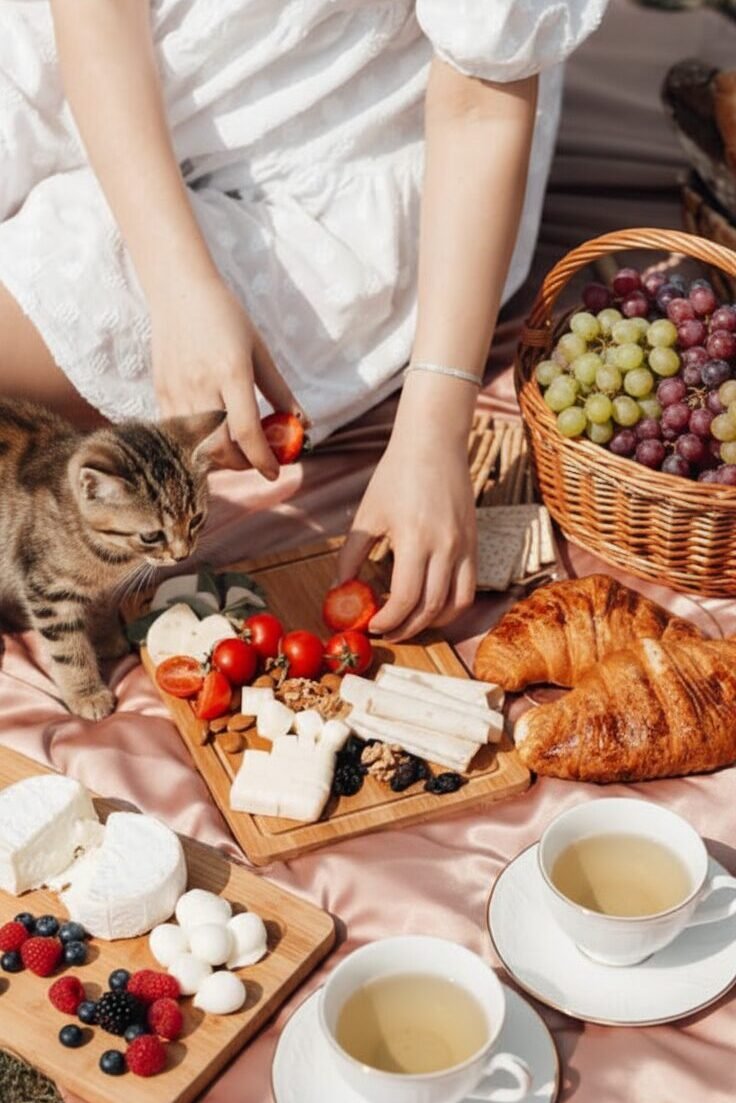
What Mistakes Should You Avoid in Tea and Cheese Pairing?
Many people choose teas that overpower or clash with cheese flavors.
Using a smoky Lapsang Souchong with delicate ricotta can leave you tasting only smoke. Avoid selecting tea or cheese based on popularity rather than compatibility.
Even celebrated aged cheddar may taste dull next to an intense black tea if their strengths don’t balance. Serving both items at the wrong temperature can limit enjoyment.
Cold cheese may hide its richness. Hot tea can overwhelm mild cheeses and mask subtle notes.
Oversweetening your tea easily throws off contrast with salty or tangy cheeses like feta. Take time to understand how each element works together before serving.
Conclusion: Discovering Your Favorite Tea and Cheese Combinations
You can create new flavor experiences when pairing tea with cheese.
Each sip and bite brings out unique notes. From creamy brie with green tea to aged cheddar matched with black tea, the combinations are exciting.
Discover which combinations delight your palate the most. Enjoy exploring the variety that cheese and tea bring together at your table.
FAQs
1. Why do tea and cheese actually work well together?
It comes down to mouthfeel and temperature. The tannins in tea (especially black and darker oolongs) act as a palate cleanser, cutting through the rich fat that cheese coats your mouth with. Additionally, unlike wine, tea is served warm. As mentioned in the article, this warmth helps melt the fats in the cheese slightly, unlocking volatile aromas and flavors that you might miss with a cold beverage.
2. What is the best serving temperature for a tasting?
Temperature is the most critical factor for success. You should never serve the cheese cold straight from the fridge. As the article suggests, let your cheese come to room temperature before serving so the flavors can bloom. However, your tea should be hot (but not scalding). The contrast between the room-temperature cheese and the warm tea creates the best textural experience.
3. Should I add milk or sugar to the tea?
Generally, you should avoid adding milk to your tea when pairing it with cheese, as the dairy in the cup can compete with or muddy the flavors of the dairy on your plate. However, there is an exception for blue cheese: the article notes that a “sweet milk tea” can help soften the intense sharpness of Stilton. Regarding sweeteners, a touch of honey or sugar works very well with salty, blue cheeses to round out the “bite,” but keep your green and white teas pure.
4. In what order should I serve the pairings?
Just like a wine tasting, you should always progress from light to strong to avoid overwhelming your palate early on.
- Start: Fresh cheeses (Ricotta, Mozzarella) with White or Herbal teas.
- Middle: Soft and Semi-Hard cheeses (Brie, Gouda) with Green or Oolong teas.
- Finish: Aged and Blue cheeses (Cheddar, Roquefort) with strong Black teas or Pu-erh.
5. I don’t drink caffeine; can I still do a pairing?
Absolutely. You don’t need tannins from tea leaves to have a great experience. The article recommends specific herbal pairings that work beautifully: try Rooibos with fresh goat cheese for a warm, sweet balance, Chamomile to highlight the sweetness in ricotta, or Hibiscus to provide a tart contrast to rich mascarpone.




